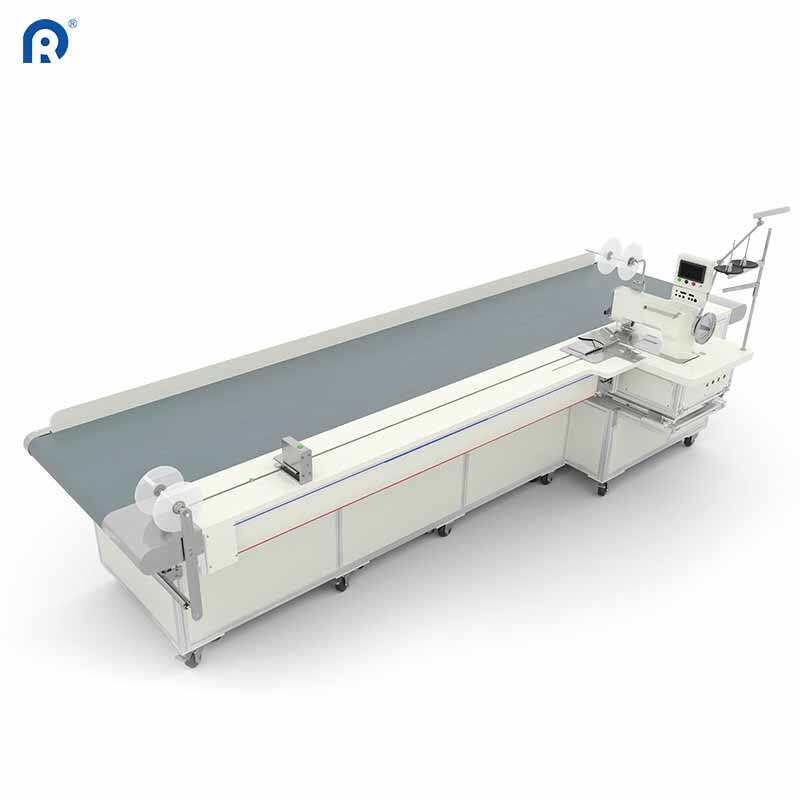Choosing the Right Curtain Hemming Machine for Cost Efficiency
Selecting the right curtain hemming machine is crucial for ensuring cost efficiency over the long term for your business. Key features to look for include energy efficiency ratings that can lead to significant savings. For instance, machines equipped with energy-efficient motors may reduce electricity costs by up to 25%, helping you to save on operational expenses. Additionally, machines with durable construction, such as metal frames and high-quality components, while initially more expensive, often provide better long-term value due to their longevity and reduced need for replacement. Finally, choosing machines that are easy to use and maintain—those requiring less frequent servicing—can substantially decrease repair and maintenance costs, contributing to overall cost savings.
Key Features That Reduce Long-Term Costs
When evaluating curtain hemming machines, it's important to consider the features that will reduce long-term costs. Energy efficiency is a critical factor. Machines with high energy-efficiency ratings can save up to 25% on electricity costs. Additionally, durability is vital; machines with metal frames and quality components, though more expensive initially, save money through their longevity and decreased need for repairs. Lastly, the ease of use and maintenance requirements play a significant role; simpler machines that require minimal servicing can further contribute to long-term cost savings by minimizing downtime and repair costs.
Comparing Industrial vs. Home Sewing Machines
Understanding the differences between industrial and home sewing machines is crucial for making a cost-effective choice for hemming curtains. While industrial machines usually require a higher initial investment, their production capacity often makes them more suited for high-volume work, maximizing economies of scale. These machines typically sew at a rate of 1,000 stitches per minute, vastly outpacing home models that average about 600 stitches per minute, ensuring a quicker return on investment through increased productivity. Furthermore, industrial machines can reduce fabric waste during high-volume operations, helping offset higher upfront costs by minimizing material expenses over time.
How Fabric Welding Machines Complement Hemming
Fabric welding machines significantly enhance cost efficiency when used in conjunction with hemming. These machines employ technology that reduces fabric fraying, thereby minimizing material waste and associated costs over time. This is particularly beneficial in mass production scenarios, where consistent-quality curtains are required. Using woven fabrics for strength and structural integrity diminishes the need for additional finishes, further cutting material expenses. In situations where reducing edge fraying is critical, the cost-efficiency of fabric welding surpasses traditional hemming methods, especially when dealing with substantial curtain orders.
Maximizing Fabric Savings With Hemming Techniques
Precision Cutting Using Fabric Cutting Tables
Utilizing fabric cutting tables can significantly enhance fabric savings through precise and strategic cutting. Fabric cutting tables are designed to offer accurate cuts that help reduce waste, an integral factor in maximizing fabric usage. Businesses that adopted precision cutting have reported up to a 15% annual decrease in fabric waste, underscoring the importance of meticulous planning. Further benefits can be realized through strategic layout planning on these tables, allowing for the maximum number of pieces to be cut from a single fabric roll, enhancing efficiency and cost-effectiveness.
Reusing Scraps: Creative Cost-Saving Ideas
In the curtain production industry, reusing fabric scraps can translate into substantial cost savings. By transforming scraps into smaller items like cushions or fabric bags, businesses can effectively minimize waste. Statistics show that companies embracing this practice saved up to 20% on material costs annually. Besides the economic benefits, such efforts align with the increasing trend of sustainability, bolstering brand image and appealing to eco-conscious consumers who prioritize environmentally responsible practices.
Batch Processing for Bulk Orders
Batch processing offers significant cost benefits by optimizing operational efficiency and reducing setup times. This approach leads to overhead reductions of up to 30% when handling bulk orders compared to single-item production. Moreover, batch processing enhances fabric utilization rates, facilitating a move toward tighter production schedules. Such efficiency improvements are pivotal in the industry, driving down costs and improving profitability through the effective management of large-scale orders.
Maintenance Tips to Extend Machine Lifespan
Daily Cleaning Routines for Industrial Machines
Implementing daily cleaning routines is crucial for maintaining the efficiency of industrial sewing machines and preventing costly breakdowns. Essential practices include removing lint, grease, and other debris that accumulate during operations. These tasks not only ensure optimal performance but also extend the machine's lifespan significantly. In fact, statistical data indicates that proper maintenance can increase a machine's lifespan by up to 50%, making it a worthy investment. Following the manufacturer's maintenance guide is also vital. This ensures compliance with warranty terms and secures the machine's peak operational performance, reducing unplanned downtime.
Affordable Replacement Part Sources
Finding affordable replacement parts for sewing machines can considerably cut down maintenance costs. Numerous online marketplaces and local suppliers offer discounted parts, providing an economical alternative to expensive manufacturer prices. A recent survey shows that businesses save an average of 40% on maintenance costs when sourcing parts from third-party vendors compared to manufacturers. However, it is important to use OEM (Original Equipment Manufacturer) parts to prevent compatibility issues and guarantee the longevity of the machines. These parts ensure the machines operate smoothly, preventing any loss of efficiency or operation quality.
Troubleshooting Common Hemming Issues
Troubleshooting common hemming issues is key to minimizing downtime and sustaining production efficiency. Common problems include thread breakage and uneven seams, both of which can be addressed with simple solutions and vigilant maintenance practices. Industry experts emphasize the impact of proactive troubleshooting in maintaining smooth operation flow and cite examples of businesses that have seen significant production improvements from such approaches. By adopting a proactive problem-solving mindset, companies can effectively reduce repair costs and ensure continuous machine operation, leading to a more efficient and successful production cycle.
DIY vs. Professional Services: When to Invest
Calculating Break-Even Points for Small Batches
Calculating break-even points is essential when deciding between DIY and professional sewing services. A break-even analysis helps us understand when the cost of investing in our sewing equipment and time justifies if compared to outsourcing. The formula used is:
[ Break-Even Point = Fixed Costs / (Unit Price - Variable Costs per Unit) ]
where fixed costs may include the purchase or maintenance of a sewing machine, while variable costs cover fabric, thread, and electricity. By examining a financial example, we can see how a small business could benefit from this analysis. For instance, if the cost of hiring a professional exceeds the break-even point, it makes financial sense to continue with DIY. Additionally, time savings, often overlooked, play a critical role in assessing the true cost. We must evaluate how much time DIY might take compared to outsourcing, factoring this into our decision.
Renting Equipment for Seasonal Demand
Renting equipment specifically tailored for peak seasons can offer substantial financial benefits. When demand spikes temporarily, maintaining sewing machines or other bulky equipment year-round is not practical. We have encountered compelling testimonials from businesses that opted for rental services during high-demand periods. These businesses reported increased profitability as they avoided the substantial upfront costs of purchasing equipment. By renting, they not only saved costs but also accessed state-of-the-art technology that might be too expensive to own. Local equipment rental services further facilitate this transition. They offer flexible terms that align with our seasonal demands, ensuring we have access to the necessary machinery only when needed. In doing so, we maximize cost efficiency and business output.
These strategies highlight how both break-even analysis and equipment rental can empower businesses, big and small, to make informed decisions that best align with their operational needs and financial goals.
Budget-Friendly Training for Staff
Free Online Resources for Hemming Techniques
Incorporating free online resources into your staff training can be a game-changer for improving hemming techniques. There are numerous high-quality tutorials and webinars available that focus specifically on hemming, allowing staff to learn at their own pace. Investing time in online learning can significantly boost productivity; in fact, it has the potential to improve production speed by up to 25%. As the textile industry continually evolves, staying updated with the latest skills is crucial for maintaining competitiveness. By embracing these free resources, businesses can ensure their team is not only proficient in current techniques but also prepared to adopt new ones efficiently.
Partnering With Local Sewing Communities
Collaborating with local sewing communities offers significant benefits for skill development and cost reduction in staff training. By sharing knowledge and techniques, businesses can capitalize on community expertise, enhancing their staff's proficiency without expensive courses. Many have experienced success by partnering with these groups, reporting reduced training costs and improved efficiency. Encouraging businesses to engage in mutual training sessions not only strengthens skills but also fosters a supportive network of local talent. This collaboration can lead to lasting relationships that benefit both the community and the business, creating a well-supported and skilled workforce.
Table of Contents
- Choosing the Right Curtain Hemming Machine for Cost Efficiency
- Key Features That Reduce Long-Term Costs
- Comparing Industrial vs. Home Sewing Machines
- How Fabric Welding Machines Complement Hemming
- Maximizing Fabric Savings With Hemming Techniques
- Maintenance Tips to Extend Machine Lifespan
- DIY vs. Professional Services: When to Invest
- Budget-Friendly Training for Staff






